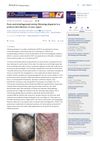TLDR Mice with the 'lanceolate hair' mutation have abnormal hair and skin similar to human Netherton's syndrome.
The document reports on a newly identified autosomal recessive mutation in house mice, named 'lanceolate hair' (lah), which was induced by ethylnitrosourea in a mutagenesis experiment. Mice with this mutation exhibited generalized alopecia due to hair shaft breakage, with the hair shafts being short and showing a lance head-like enlargement at the breakpoint. The hair fibers measured between 2.0 to 3.5 mm and had a normal base, indicating a synchronized developmental defect. Histological analysis showed abnormal cornification in the matrix region of anagen follicles and pronounced dystrophy in catagen follicles, while telogen follicles appeared almost normal. Additionally, there was significant thickening of the epidermis and a non-scarring, relatively non-inflammatory ichthyosiform dermatitis. These symptoms are similar to those of Netherton's syndrome in humans, suggesting that the lah mutation could serve as a model for this condition. The mutation was localized to the centromeric end of mouse Chromosome 18.
124 citations
,
January 1995 in “The journal of allergy and clinical immunology/Journal of allergy and clinical immunology/The journal of allergy and clinical immunology” Netherton's syndrome is linked to high IgE levels and unique skin and hair symptoms, and may improve with ammonium lactate lotion and allergy management.
178 citations
,
June 1994 in “Journal of Investigative Dermatology” Alopecia areata in these mice is inherited, more common in young females, and can be treated with triamcinolone acetonide.
22 citations
,
March 1994 in “Journal of Heredity” A mutation in mice causes hair loss and immune problems.
21 citations
,
December 1991 in “Annals of the New York Academy of Sciences” Most mouse hair keratin genes are on chromosomes 11 and 15.
264 citations
,
October 1958 in “Archives of Dermatology” A 4-year-old girl has a rare hair condition causing fragile, short hair.
 March 2023 in “Journal of Cosmetic Dermatology”
March 2023 in “Journal of Cosmetic Dermatology” A woman's progressive hair loss was correctly diagnosed as a rare condition called fibrosing alopecia in a pattern distribution after initially being mistaken for a more common type.
 November 2019 in “Harper's Textbook of Pediatric Dermatology”
November 2019 in “Harper's Textbook of Pediatric Dermatology” Understanding normal hair growth and loss in children is key to diagnosing and treating hair disorders.
 2 citations
,
March 2019 in “Journal of Dermatology”
2 citations
,
March 2019 in “Journal of Dermatology” Trichoscopy helped diagnose and treat a woman with two different types of hair loss.
Trichotillometry can measure hair plucking force, aiding alopecia treatment evaluation.
June 2001 in “European Journal of Dermatology” A 54-year-old woman experienced progressive hair loss starting in adolescence, leading to sparse scalp hair and almost no eyebrows or eyelashes.
29 citations
,
March 2000 in “Journal of Investigative Dermatology” The gene for Marie Unna hereditary hypotrichosis is located on chromosome 8p21.
189 citations
,
May 1991 in “Medical Entomology and Zoology”


